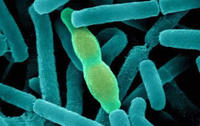-
Promising anthrax treatment study results

Researchers find that a multi-agent prophylaxis which is initiated within twenty-four hours after the infection, prevented the development of fatal anthrax respiratory disease; treatment which combines antibiotics with immunization and a protective antigen-based vaccine offered long-term immunity against the disease
-
-
Information about Maryland biolabs scarce
High-level containment laboratories and storage facilities that handle dangerous biological agents exist in Frederick County, Maryland, outside the secured gates of Fort Detrick, but state law mandates that the number and location of each remains confidential; supporters of the current system say that confidentiality is critical to maintain the security and safety of the labs, but critics argue that the secrecy makes it impossible for emergency services in the neighborhood to prepare properly for accidents
-
-
Controversy of Kansas biosecurity lab continues

KSU attracted the $650 million National Bio and Agro-Defense Facility for making vaccines and anti-virals to combat the world’s most dangerous animal diseases, beating out the competition during a multi-year screening process; in addition, KSU is planning a 26 April open house for a brand-new “innovation campus” west of Kansas City that will provide graduate level and professional science master’s degree programs (targeted versions of traditional academic programs) as well as industry training in animal health, food safety, and bio-security for more than 120 companies located in the “Kansas City animal health corridor”; critics say that building such a lab in Kansas — one of the largest livestock producing states, and a state which lies at the nation’s transportation crossroads and in the middle of Tornado Alley — is not such a good idea
-
-
Abbott shows new pathogen detector
Illinois-based pharmaceutical company Abbott unveiled a new assay system that can accurately detect seventeen different bio-threat pathogens; among different bio-agents targeted in the new test are Bacillus anthracis, E. coli, salmonella, Ebola virus, and avian influenza viruses; the company says the new method provides results in less than eight hours
-
-
Harris Corp. awarded $9 million Army contract to boost biodefense
The U.S. Army recently signed a $9 million deal with Harris Corp. to bolster the army’s biological defense capabilities; Harris will provide the Army’s Joint Biological Point Detection System (JBPDS) with its advanced Falcon II AN/PRC-150 high-frequency radio system; the radio system is capable of detecting and identifying biological warfare agents and will automatically send alerts to headquarters when it senses the presence of these agents; JBPDS is a portable self-contained unit designed to automatically detect and identify airborne biological agents
-
-
Terror attack fears over London virus superlab
Experts express concern over the 600 million Pound virus “superlab” planned for St. Pancras, London; the 14-story, maximum security site containing viruses including malaria, tuberculosis, bird and swine flu, cancer cells, and HIV would need to be “bulletproof” to withstand not only an earthquake, a bomb, or fire — there are also worries that Tube trains running through King’s Cross and Euston stations could ruin delicate and expensive laboratory equipment
-
-
Universal flu vaccine within sight
People need to be vaccinated against flu every year because the flu virus is a scam artist: it uses a big, showy surface protein — and there are sixteen different varieties of this protein, called Hemagglutinin (HA) — to attract your immune system, then changes it so your immune system would not recognize it next time round; vaccines must thus change yearly to match it; scientists discover HA’s Achilles Heel: a vital part of the HA’s viral machinery does not vary much over time or between viruses, meaning that a vaccine based on the this part would be a universal flu vaccine
-
-
T cells offer new promise for vaccines for plague and bacterial pneumonias
There is currently no licensed plague vaccine in the United States, which is too bad because Yersinia pestis is arguably the most deadly bacteria known to man; most of the plague vaccine candidates that have been studied aim to stimulate B cells to produce plague-fighting antibodies, but animal studies suggest that antibodies may not be enough to protect humans from pneumonic plague; new studies show that T cells can also fight plague — and may be better candidates with which to develop a plague vaccine
-
-
BioShield projects sees vaccine, treatments successes
Efforts on behalf of the U.S. Department Health and Human Services to ensure that the United States has medical countermeasures (MCMs) available for responding to a chemical, biological, radiological, or nuclear (CBRN) event have been successful in developing the first human vaccine for avian flu, as well as delivering treatments for anthrax (vaccines and therapeutics), radiation exposure, and botulism to the Strategic National Stockpile (SNS)
-
-
Gerald Epstein: No military angle to debate over small pox sample retention
There is an honest debate among scientists whether to destroy or retain the world’s last remaining smallpox sample; one argument that is not being made is these samples should be retained for possible use as a weapon; the assertion that some of U.S. scientists or government officials who argue for retaining the samples, do so because of the potential use of smallpox as a bioweapon, has no basis in fact; moreover, the indiscriminate spread of small pox makes it unsuitable as a weapon, since its effects could not be limited to the military forces or even the population of an attacking state
-
-
Dr. Kavita Berger, biosecurity expert
Project BioShield, launched in 2004 with a $5 billion funding from Congress, aims to encourage the development of vaccines against bioterror agents; the project has divided the scientific community with regard to the direction of R&D effort funded by the project; some scientists in the field argue that the development and stock-piling of vaccines for known diseases, such as polio, plague, botulism, and anthrax, is a waste of funding — funding which could, and should, be used to develop a universal vaccine which would counteract not only known bioterror agents, but yet-unknown agents, also called “designer pathogens”
-
-
Randall Larsen, executive director of the WMD Commission
Critics point out that Project BioShield, created in 2003 to address the lack of medical countermeasures to deal with chemical, biological, radiological, or nuclear terrorism agents, is yet to deliver a single vaccine to any of the known bioterror agent; they also point out to the cancellation of a $877.5 million contract with an inexperienced San Francisco company to develop an anthrax vaccine as emblematic of the program; Randall Larsen, executive director of the WMD Commission, argues that “There are always going to be problems when you’re making a new stealth bomber, nuclear powered submarine, or pharmaceutical for biodefense—- “; he also points out that the EPA R&D budget is about half the budget of the Marine Corp. marching band
-
-
K-State doctoral dissertation examines food bioterrorism
Terrorist “chatter” and information gleaned from informants have led DHS to warn restaurants and hotels that terrorists are planning to use biological agents to contaminate food in readily accessible areas such as salad bars, cafeteria food displays, and more; a Kansas State graduate student writes a dissertation on how restaurants in country clubs protect themselves against this risk; he finds that they do not do much
-
-
U.S. not ready for bioterrorism
New report finds that if a major disease incident or bioterrorism attack were to occur today, the United States would not be ready for it; significant local, state, and federal budget cuts have had a negative impact on public health departments’ ability to maintain staff capabilities, and their ability to respond to crises
-
-
Feds warn of food-borne, other poison-based threats
U.S. federal authorities believe a food-borne attack on the U.S. homeland is unlikely, but they are still urging businesses and local law enforcement to keep watch for such an attack and a smorgasbord of other poison-based threats, including the possible contamination of skin products or even handrails at public places
-
- All
- Regional
- Water
- Biometrics
- Borders/Immig
- Business
- Cybersecurity
- Detection
- Disasters
- Government
- Infrastructure
- International
- Public health
- Public Safety
- Communication interoperabillity
- Emergency services
- Emergency medical services
- Fire
- First response
- IEDs
- Law Enforcement
- Law Enforcement Technology
- Military technology
- Nonlethal weapons
- Nuclear weapons
- Personal protection equipment
- Police
- Notification /alert systems
- Situational awareness
- Weapons systems
- Sci-Tech
- Sector Reports
- Surveillance
- Transportation
Advertising & Marketing: advertise@newswirepubs.com
Editorial: editor@newswirepubs.com
General: info@newswirepubs.com
2010-2011 © News Wire Publications, LLC News Wire Publications, LLC
220 Old Country Road | Suite 200 | Mineola | New York | 11501
Permissions and Policies
Editorial: editor@newswirepubs.com
General: info@newswirepubs.com
2010-2011 © News Wire Publications, LLC News Wire Publications, LLC
220 Old Country Road | Suite 200 | Mineola | New York | 11501
Permissions and Policies
